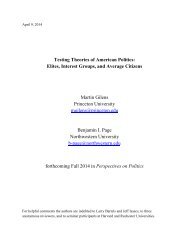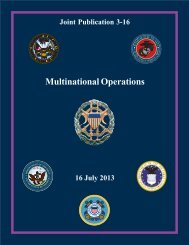ABUSE OF STRUCTURED FINANCIAL PRODUCTS- Misusing Basket Options to Avoid Taxes and Leverage Limits MAJORITY AND MINORITY STAFF REPORT
ABUSE OF STRUCTURED FINANCIAL PRODUCTS- Misusing Basket Options to Avoid Taxes and Leverage Limits MAJORITY AND MINORITY STAFF REPORT
ABUSE OF STRUCTURED FINANCIAL PRODUCTS- Misusing Basket Options to Avoid Taxes and Leverage Limits MAJORITY AND MINORITY STAFF REPORT
You also want an ePaper? Increase the reach of your titles
YUMPU automatically turns print PDFs into web optimized ePapers that Google loves.
3<br />
client entered in<strong>to</strong> a contract with the bank <strong>to</strong> purchase an “option” on the performance of an<br />
unspecified basket of assets placed in a designated account. The referenced account was opened<br />
in the name of the bank <strong>and</strong> operated as the bank’s own proprietary trading account. All assets<br />
were purchased in the name of the bank.<br />
To reduce trading risk, the option contract normally set a few basic parameters for the<br />
assets that could be purchased for the account, but otherwise provided wide discretion over the<br />
assets <strong>to</strong> be selected. The hedge fund was required <strong>to</strong> deposit in<strong>to</strong> the account a cash “premium,”<br />
which typically consisted of funds representing about 10% of the <strong>to</strong>tal capital <strong>to</strong> be invested in<br />
the account <strong>and</strong> functioned as collateral for the account. The sponsoring bank financed the other<br />
90% of the capital <strong>to</strong> be invested, <strong>and</strong> the hedge fund paid financing fees on that financed<br />
amount. The designated account then used the funds from the premium <strong>and</strong> credit extension <strong>to</strong><br />
conduct trades until the option holder exercised the option. If at the time the option was<br />
exercised, the securities in the referenced account had produced a profit, the bank had <strong>to</strong> pay<br />
those profits <strong>to</strong> the hedge fund holding the option, after subtracting fees for certain trading,<br />
financing, <strong>and</strong> other expenses.<br />
In the basket option contracts examined by the Subcommittee, the bank always appointed<br />
the general partner of the hedge fund client <strong>to</strong> act as the investment advisor for the trading<br />
account holding the referenced assets during the duration of the option. Once appointed, the<br />
investment adviser exercised complete control over the securities included in the option account,<br />
designing its own trading strategy <strong>and</strong> using the bank’s own facilities <strong>to</strong> execute the trades. In<br />
some cases reviewed by the Subcommittee, the investment advisor used algorithms <strong>to</strong> engage in<br />
a high volume of trading, executing more than a 100,000 transactions per day. Many of those<br />
trading positions lasted minutes, <strong>and</strong> the overall composition of the securities basket changed on<br />
a second-<strong>to</strong>-second basis. One basket option account later reviewed by the Securities <strong>and</strong><br />
Exchange Commission (SEC) was found <strong>to</strong> have experienced 129 million orders in a year. In<br />
other cases, the investment adviser purchased securities whose positions remained unchanged for<br />
weeks, but all of the basket option accounts reviewed by the Subcommittee were dominated by<br />
short-term trading involving assets held less than one year.<br />
By acting as the investment adviser, the hedge fund – the option holder – became the<br />
party that actually controlled the trading strategy, the timing of trades, <strong>and</strong> what assets were<br />
selected for the referenced account. The hedge fund was also exposed <strong>to</strong> all significant rewards<br />
<strong>and</strong> risks associated with the trading. The banks claimed that the hedge funds did not bear 100%<br />
of the risk of loss, because the banks provided so-called “gap” protection in the event of a<br />
catastrophic market failure. That risk was so small, however, that despite, for example, hundreds<br />
of millions of trades that <strong>to</strong>ok place in the more than 60 basket options held by RenTec over a<br />
decade, including during the worst financial crisis in a generation, neither bank was ever required<br />
<strong>to</strong> satisfy a loss due <strong>to</strong> a market failure.<br />
To further minimize the gap risk, the option contract contained several provisions<br />
designed <strong>to</strong> limit trading losses in the account <strong>to</strong> the 10% premium provided by the hedge fund.<br />
The key provision accomplished that objective by specifying a loss threshold – sometimes called<br />
a “barrier” or “knockout” amount – which if reached would cause the option <strong>to</strong> cease <strong>to</strong> exist, or<br />
“knockout,” <strong>and</strong> trigger the ability of the bank <strong>to</strong> liquidate the account assets.







